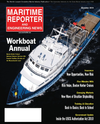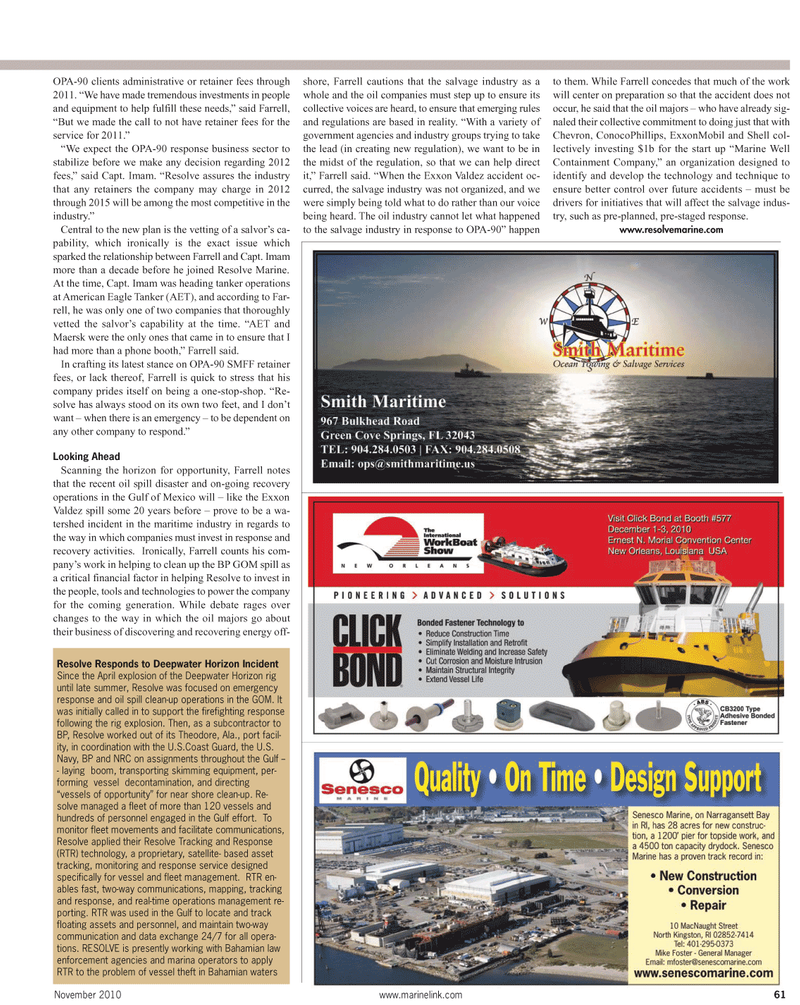
Page 63: of Maritime Reporter Magazine (November 2010)
Workboat Annual
Read this page in Pdf, Flash or Html5 edition of November 2010 Maritime Reporter Magazine
OPA-90 clients administrative or retainer fees through 2011. “We have made tremendous investments in people and equipment to help fulfill these needs,” said Farrell, “But we made the call to not have retainer fees for the service for 2011.” “We expect the OPA-90 response business sector to stabilize before we make any decision regarding 2012 fees,” said Capt. Imam. “Resolve assures the industry that any retainers the company may charge in 2012 through 2015 will be among the most competitive in the industry.”
Central to the new plan is the vetting of a salvor’s ca- pability, which ironically is the exact issue which sparked the relationship between Farrell and Capt. Imam more than a decade before he joined Resolve Marine.
At the time, Capt. Imam was heading tanker operations at American Eagle Tanker (AET), and according to Far- rell, he was only one of two companies that thoroughly vetted the salvor’s capability at the time. “AET and
Maersk were the only ones that came in to ensure that I had more than a phone booth,” Farrell said.
In crafting its latest stance on OPA-90 SMFF retainer fees, or lack thereof, Farrell is quick to stress that his company prides itself on being a one-stop-shop. “Re- solve has always stood on its own two feet, and I don’t want – when there is an emergency – to be dependent on any other company to respond.”
Looking Ahead
Scanning the horizon for opportunity, Farrell notes that the recent oil spill disaster and on-going recovery operations in the Gulf of Mexico will – like the Exxon
Valdez spill some 20 years before – prove to be a wa- tershed incident in the maritime industry in regards to the way in which companies must invest in response and recovery activities. Ironically, Farrell counts his com- pany’s work in helping to clean up the BP GOM spill as a critical financial factor in helping Resolve to invest in the people, tools and technologies to power the company for the coming generation. While debate rages over changes to the way in which the oil majors go about their business of discovering and recovering energy off- shore, Farrell cautions that the salvage industry as a whole and the oil companies must step up to ensure its collective voices are heard, to ensure that emerging rules and regulations are based in reality. “With a variety of government agencies and industry groups trying to take the lead (in creating new regulation), we want to be in the midst of the regulation, so that we can help direct it,” Farrell said. “When the Exxon Valdez accident oc- curred, the salvage industry was not organized, and we were simply being told what to do rather than our voice being heard. The oil industry cannot let what happened to the salvage industry in response to OPA-90” happen to them. While Farrell concedes that much of the work will center on preparation so that the accident does not occur, he said that the oil majors – who have already sig- naled their collective commitment to doing just that with
Chevron, ConocoPhillips, ExxonMobil and Shell col- lectively investing $1b for the start up “Marine Well
Containment Company,” an organization designed to identify and develop the technology and technique to ensure better control over future accidents – must be drivers for initiatives that will affect the salvage indus- try, such as pre-planned, pre-staged response. www.resolvemarine.com
November 2010 www.marinelink.com 61
Resolve Responds to Deepwater Horizon Incident
Since the April explosion of the Deepwater Horizon rig until late summer, Resolve was focused on emergency response and oil spill clean-up operations in the GOM. It was initially called in to support the firefighting response following the rig explosion. Then, as a subcontractor to
BP, Resolve worked out of its Theodore, Ala., port facil- ity, in coordination with the U.S.Coast Guard, the U.S.
Navy, BP and NRC on assignments throughout the Gulf -- - laying boom, transporting skimming equipment, per- forming vessel decontamination, and directing “vessels of opportunity” for near shore clean-up. Re- solve managed a fleet of more than 120 vessels and hundreds of personnel engaged in the Gulf effort. To monitor fleet movements and facilitate communications,
Resolve applied their Resolve Tracking and Response (RTR) technology, a proprietary, satellite- based asset tracking, monitoring and response service designed specifically for vessel and fleet management. RTR en- ables fast, two-way communications, mapping, tracking and response, and real-time operations management re- porting. RTR was used in the Gulf to locate and track floating assets and personnel, and maintain two-way communication and data exchange 24/7 for all opera- tions. RESOLVE is presently working with Bahamian law enforcement agencies and marina operators to apply
RTR to the problem of vessel theft in Bahamian waters

 62
62

 64
64
